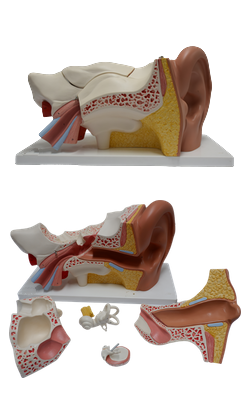Main Model

Middle ear : 7 Pharyngotympanice tube

The pharyngotympanic tube (auditory tube) connects the tympanic cavity to the nasopharynx, where it opens posterior to the inferior nasal meatus. The posterolateral third of the tube is bony, and the remainder is cartilaginous. The pharyngotympanic tube is lined by mucous membrane that is continuous posteriorly with that of the tympanic cavity and anteriorly with that of the nasopharynx.
The function of the pharyngotympanic tube is to equalize pressure in the middle ear with the atmospheric pressure, thereby allowing free movement of the tympanic membrane. By allowing air to enter and leave the tympanic cavity, this tube balances the pressure on both sides of the membrane. Because the walls of the cartilaginous part of the tube are normally in apposition, the tube must be actively opened. The tube is opened by the expanding girth of the belly of the levator veli palatini as it contracts longitudinally, pushing against one wall while the tensor veli palatini pulls on the other. Because these are muscles of the soft palate, equalizing pressure (“popping the eardrums”) is commonly associated with activities such as yawning and swallowing.
The arteries of the pharyngotympanic tube are derived from the ascending pharyngeal artery, a branch of the external carotid artery, and the middle meningeal artery and artery of the pterygoid canal, branches of the maxillary artery.
The veins of the pharyngotympanic tube drain into the pterygoid venous plexus. Lymphatic drainage of the tube is to the deep cervical lymph nodes.
The nerves of the pharyngotympanic tube arise from the tympanic plexus, which is formed by fibers of the glossopharyngeal nerve (CN IX). Anteriorly, the tube also receives fibers from the pterygopalatine ganglion.